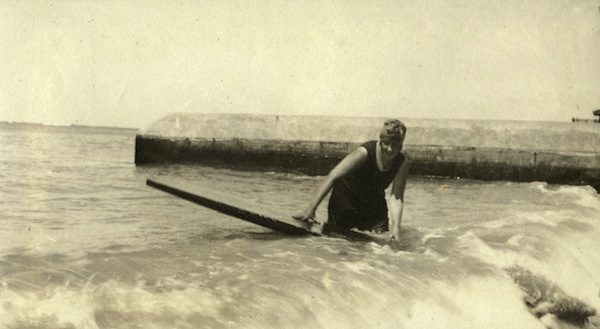If you asked surfers who was the first Western European woman to stand up on a surfboard, it is unlikely that they would think of Agatha Christie, the iconic crime novelist and one of the bestselling writers of all time. In 1922, the young, adventurous travelling Agatha Christie got the surfing bug with her husband Archie on a year-long around-the-world trip. She recounts in her autobiography that, “whenever we could steal time off…we took the train and went to Muizenberg (South Africa), got our surf boards, and went out surfing together.” Later in Hawaii, she wrote, “I learned to become an expert… Nothing like that rushing through the water at what seems to you a speed of about two hundred miles an hour; all the way in from the far distant raft, until you arrived, gently slowing down, on the beach, and foundered among the soft flowing waves. It is one of the most perfect physical pleasures that I have known.”
Surfing and literature
What the ‘physical pleasures’ of surfing and creative writing share in common is indulgence in the metaphor. A metaphor is a use of language that takes one notion across to another, bigger, more expansive notion to increase its quality, intensity and presence. The word ‘metaphor’ simply means ‘to transfer’ or ‘carry across’. “The wave was punchy” is a classic metaphor used by surfers around the world. Of course, the wave doesn’t literally ‘punch’, but figuratively speaking, of course it packs a punch. The literal idea of the punch is carried across to the breaking wave as a bigger, more complex idea – the punchy power of the folding water.
“The glassy wave combed by a light offshore” is another classic surf metaphor. Of course, the wave isn’t literally made of glass, or literally ‘combed’ by the wind, but figuratively speaking, the wave looks like glass - transparent, shattering on impact; and the wind pulls through the wave like a comb so that spray raises like hair. The wave is figuratively hair-raising. Metaphors clearly bring depth, quality and intensity to otherwise plain speaking. In this sense, surfing is a metaphor for gliding. We ‘surf’ the internet because we glide around it with ease, with no apparent energy source. Good surfers glide on and around waves with such ease. To watch them is to view metaphors in action. They are more than motion - they are poetry in motion.
When, in 1907, the writer Jack London spent his first tranche of royalties for his best-selling novel Call of the Wild on a boat trip to Hawaii, he stood on the beach at Waikiki and watched surfers riding from out back all the way onto the sand on heavy wooden boards. As a waterman himself, Jack immediately appreciated the beauty of surfing. But how did he describe the scene? “I saw a guy standing upright on a wooden board”? Nah. He writes: “He is Mercury – a Brown Mercury. His heels are winged, and in them is the swiftness of the sea.” The description is poetic, metaphorical: ‘winged heels’, ‘swiftness of the sea’. The surfer (George Freeth, who taught Jack to surf) takes on the qualities of the sea itself as it pushed relentlessly towards shore, rising as waves that break on the sand. The surfer is a messenger born of the sea and borne by it. The surfer is himself a wave, mercurial, swift-footed. Creative writers like Jack London crank up the metaphor count to breathe life into language.
Agatha Christie was another great writer: “The surf boards in South Africa were made of light, thin wood, easy to carry, and one soon got the knack of coming in on the waves,” wrote Agatha Christie. “It was occasionally painful as you took a nosedive down into the sand, but on the whole it was an easy sport and great fun.” Ultimately she stood up, delighted: “Oh, it was heaven! Nothing like it. Nothing like that rushing through the water at what seemed to you a speed of about two hundred miles an hour; all the way in from the far distant raft, until you arrived, gently slowing down, on the beach, and foundered among the soft flowing waves.”
Anne Beddingfeld, one of Agatha’s characters in the novel The Man in the Brown Suit, is described surfing in Cape Town: “Surfing looks perfectly easy. It isn’t. I say no more. I got very angry and fairly hurled my plank from me. Nevertheless, I determined to return on the first possible opportunity and have another go. I would not be beaten. Quite by mistake I then got a good run on my board, and came out delirious with happiness. Surfing is like that. You are either vigorously cursing or else you are idiotically pleased with yourself.” This may be the first time that the common nickname (a metaphor) ‘plank’ for a board had been used outside surfing circles. And Agatha brilliantly captures those dual experiences of surfing as both infuriating and rewarding.
Agatha Christie’s most famous character Hercule Poirot was never reported hanging ten, nor did her other famous character Miss Marple wax up her plank, but Agatha’s success as a British crime writer (she sold over a billion copies of her 80 novels) was certainly injected with a little saltwater soul. She got the bug, and was likely Western Europe’s first female stand-up surfer. “Instinct is a marvellous thing. It can neither be explained nor ignored,” concluded Agatha in The Mysterious Affair at Styles. This would be a great description for the timeless allure of surfing.
